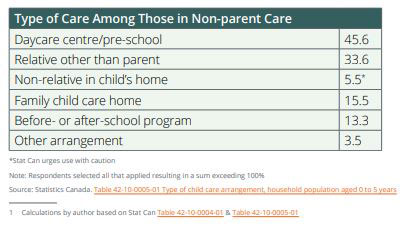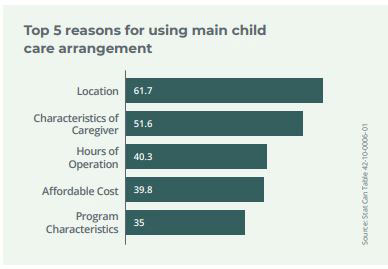New Provincial Child Care Data
Child care policies should be equitable for all families, regardless of the type of care they choose. Yet child care policy in Canada primarily directs funding toward centre-based care. The recent Statistics Canada Survey on Early Learning and Child Care Arrangements, 2019 and follow up analysis Early Learning and Child Care for Children aged 0 to 5 years: A Provincial/Territorial Portrait show that parents use a variety of arrangements, and the majority of parents receive no benefit when provinces fund centre-based care. Ontario should take a neutral approach that respects the diverse arrangements parents make for their children.
Child care policies should be equitable for all families, regardless of the type of care they choose. Federal policy-makers must respect the diversity of choices parents make.
Principles of Equitable Child Care Policy: Diversity and Neutrality
Diversity: Parents Rely on Diverse Care Arrangements
Child care is the care of a child regardless of who provides the care. Parents rely on diverse care options for their children, and public policy should recognize and support the choices parents make for their families.
In Ontario, about 54 percent of children under six years old are in non-parental care. Of these, about 46 percent are in child-care centres or in a preschool program. This means that when we consider all children in Ontario under the age of six—those in parental care and those not—only 24 percent are currently in centre-based care or preschool.1 A majority of Ontario children under six will receive no benefit from the billion dollars designated toward funding new spaces.
Type of child care arrangement among those in non-parental care, household population aged zero to five years, Ontario

Neutrality: Policy-Makers Must Respect Diverse Parental Needs
Ontario should opt for the neutral approach demonstrated in the introduction of the CARE credits that respect the needs and choices of parents.
It is often reported that child care spaces are scarce, yet in Ontario, nearly 64 percent of parents who use non-parental child care report having no problem finding care. In fact, the Statistics Canada suggests that less than 3 percent of children in Ontario are not in care because of a shortage of space. Rather than funding one form of care in response to a perceived crisis, Ontario should take a neutral, evidence-based approach and respect the diversity of care parents choose.

Parents choose care based on their needs. According to the survey, the top reasons parents who use care select the type of care they do are location (61.7%), the characteristics of the individual providing care (51.6%), and the hours of operation (40.3%). Furthermore, many parents depend on in-home care or relatives, while about 46 percent of parents with children under six in Ontario do not currently use non-parental care.
Ontario parents who use funded daycare spaces receive preferential treatment. In addition to receiving a subsidized space, they can claim child care income tax deductions from both the federal and provincial government. Nearly one-fifth of children under six in Ontario are cared for by a stay-at-home parent who chooses to remain home with them. However, these families receive no benefits from these programs.
A Positive Vision
Ontario must seek maximum freedom and flexibility when negotiating bilateral agreements with the federal government, ensuring funding can be leveraged toward equitable treatment of all families with children.
Ontario can create more choices for parents by eliminating unnecessary discrimination against marketbased, home-based, or other independent child care providers. This objective can be achieved in part by
- Simplifying the reporting process for independent child care inspectors. Inspections of independent child care providers vary widely between inspectors. Standardizing the approach would allow for consistent and objective reporting.
- Improving the licensing process. Seeking accreditation as a licensed independent child care provider is difficult and expensive. Licensing fees can cost an independent provider $10 per child a day while providing little benefit in return. To increase quality options for parents, the province should consult with independent providers to reform the licensing process.
Ontario is to be commended for taking positive strides toward a more equitable child care regime with the implementation of the CARE tax credit. Spending a billion dollars on school-based child care spaces serves only a small portion of Ontario children. Ontario should continue to focus on child care policies that are equitable for all families, regardless of the type of care they choose.

